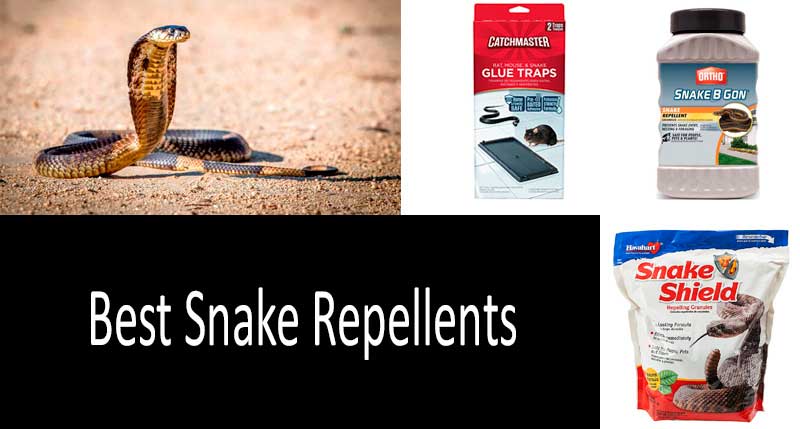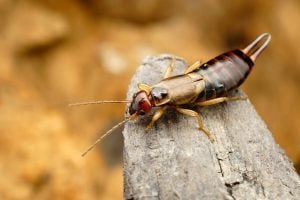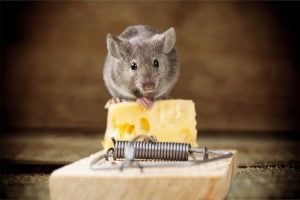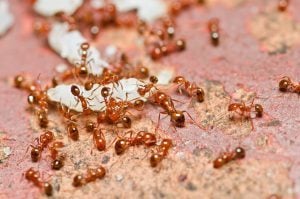How to repel snakes? There is a general animosity between humans and wild snakes. So to help you protect your children, pets and yard, we are going to show you various options to trap and repel snakes. Although we understand that killing these reptiles is not beneficial for an eco system, we also share your concern for the danger these creatures can pose to our families and furry friends. There is still a lack a 100%-effective product for protection and scientists claim that you can’t simply rely on traditional methods as they are often useless. So what are we supposed to do when we see a snake in or near the house?
Our review is based on the scientists’ and state experts’ advice. We have also paid attention to the opinions of experienced farmers and hunters. What we all can agree on is that it is unacceptable to have these creatures making our home their own. You’d better take care and repel them as far away from your home as possible. Here you’ll find best snake repellents and traps.
{code 416}
- How to Keep the Snakes Away: Snake Traps, Fences and Traditional Methods
- best Ready-to-Use Snake Repellents
- Best Ready-to-use Snake Traps
Are There Effective Snakes Repellents?
We’re used to buying repellents for eliminating rodents, insects and other pests as it is really easy and convenient to create a liquid or dry barrier which will repel but not harm a live creature. Things aren’t that simple with the snakes.
Even official state sources contradict each other when it comes to the effectiveness of the repellents. They all nevertheless agree that no universal repellent against all types of snakes exists. What does science have to say about the products which are traditionally used and which are sold on the stores’ shelves?

Let’s start with a bit of history. Back in the 1950s you could come across the manuals on using poisons (from DDT to cyanogas, from mercaptan to nicotine sulfate) against snakes, but none of them was proven to be 100% effective. Later most of the products based on these chemicals were banned. Highly concentrated mercaptan, for example, was harmful for human nervous system, although its impact on non-venomous snakes wasn’t proven.
Nowadays you can come across a short list of the safest repellent chemicals and actual repellents containing them on farmers’ forums and ad portals. However, science does not fully acknowledge any of them.
Chemical Snake Repellents: Mothballs and Sulfur
- Mothballs (naphthalene)
First of all, these balls contain a strong neurotoxin. Should a child or a dog get it into its mouth, it is very dangerous. Second, its effectiveness against snakes has not been scientifically proven. National Pesticide Information Center claims directly: «Mothballs are not a snake repellent».
If you do not believe scientists, just watch the “Mythbusters” episode. Adam Savage and friends have busted this myth as well. In addition, the lab experiments with pure naphthalene showed that it is not a barrier for the snakes.
The scientists Gary J. San Julian and David K. Woodward have conducted an experiment to prove this. They placed the snake in a closed box, poured the repellent before it and placed some bait there too. Almost all the time the reptile ignored the mothball barrier.
- Sulfur
Pure sulfur is rarely used against snakes. Most often it is mixed with naphthalene. The only thing we can say about this mixture is that it stinks and that it is easily washed away by rain. Perhaps, a certain concentration of the two ingredients can affect snakes.
The article “Snakes: Information for Kentucky Homeowners” claims that the effectiveness of certain naphthalene- and sulfur-based registered products is limited. This is also confirmed by the fact that certain sulfur and naphthalene repellents have been licensed. They work best against rattlesnakes and checkered garter snakes with certain disclaimers, though.
For instance, a 7% naphthalene and 28% sulfur Snake-A-Way didn’t pass the lab tests. Rex E. Marsh from University of California of California — Davis has placed a repellent strip on the floor and let the snakes in one by one. Statistically, one of the two gopher snakes crossed the barrier several times. Moreover, Snake-a-Way’s rivals are not known to be versatile repellents either.
Homemade and Natural Snake Repellents
Fox urine, smoke, diesel fuel and the mixture of naphthalene with feline filler, lime and pepper sprays are known to be traditional snake repellents. Gary J. San Julian and David K. Woodward claim that all of these items are ineffective. Diesel fuel is also considered to be extremely harmful for the environment by the experts as your plants and useful insects in the garden will be affected by it. However, some Colorado researches believe that it has a restricting impact on rattlesnakes.
What about organic essential oil repellents? Such mixtures are popular for eliminating garden pests, but none of them are useful against snakes. Jim Parkhurst, Associate Professor, Fish and Wildlife Conservation, Virginia Tech covers that the state is developing a product containing cinnamon, clove and eugenol essential oils. However, he personally doesn’t condone this technique.
{code 32}
How Effective are Snake Repellents?
The Inland Fisheries and Wildlife Department of Maine web portal will help us summarize the mini-review of snake repellents. The authors of their booklet devoted to the snakes radically claim that no chemical products are effective against snakes. Perhaps this is connected with the smell of these reptiles, as they perceive the smell with their forked tongue. That’s why they are not repelled by distant smells and they will only feel it physically if they lick the ground.
What you certainly shouldn’t buy is the products which are positioned as universal ones, which would apparently help you to get rid of rats, spiders and snakes. NPIC specialists are positive that these products are the worst. Also, do neglect the ultrasound repellents, as snakes have no ears!
Nevertheless, we were somehow interested in the powders and granules based on sulfur and naphthalene. The experts do not have a unified opinion regarding them, so let’s consider them to be potential snake repellents. Later we’ll find out what do mere consumers think about such repellents.
{code 359}
Physical measures can be more effective against snakes. The Maine ecologists’ brochure states that the best way to protect oneself against these slithering creatures is to bury a solid fence deep into the ground. Moreover, various types of reptile traps are quite popular. It isn’t that hard to get one of them.
Buy or build a snake-proof fence. Let’s refer to the same fence fans’ booklet, where they give a universal instruction on erecting it:
“Make a fence from quarter-inch mesh galvanized hardware cloth, 30 inches high. Bury the bottom edge three to six inches in the ground, placing the support stakes inside the fence to prevent snakes from crawling up them. You can construct this fence alone or add it to the front of an existing fence. Any gate should fit tightly and be kept closed. Regularly inspect the fence to be sure that holes haven’t been opened under it, and that items have not been piled against the outside. Mow grass and weeds around the fence. A snake fence should slant outward at a 30-degree angle toward the area containing snakes.”
Buy or make your own glue snake trap. The experts approve of using sticky traps for keeping the snakes trapped. Such things are available. The zoologists from Washington describe to you how to make such a trap by yourself:
“Place the rat-sized glue board trap attached to a piece of plywood along an inside wall or foundation. To avoid close contact with an agitated snake, consider fastening a wood extension handle. To release a snake caught in the glue board trap pour vegetable oil on the snake. The oil will reduce the tackiness of the glue and allow the snake to free itself”.
Use humane sticky traps.
According to the experts from the University of Florida: “..there are a variety of humane glueboard snake traps. When these traps are in use, they MUST be checked daily so that snakes do not die from lack of moisture and begin to smell. Captured nonvenomous snakes can easily be set free at a nearby natural area by pouring vegetable oil onto the snake to release it from the glue. If you have a venomous snake in your home, or if you capture a venomous snake in a glue trap, leave it alone and call a professional.”
Use funnel traps. For those who love DIY without using glue, the DEM in the State of Rhode Island offer a handmade trap blueprint along with the instructions:
“One method used by researchers to capture snakes is a funnel trap with drift fences. A funnel trap is cylindrical wire mesh structure, using the same basic concept as a lobster pot. One or both ends of the cylinder are fitted with entrance funnels, with the narrow end located within the body of the trap. Since such traps are not available commercially, they must be handfabricated, a process which makes their use unappealing and time-consuming”.
Pets are also considered to be physical measures against snakes. Pigs, dogs and hedgehogs are considered to feed on certain types of reptiles. But only hedgehogs do so on a regular basis. Others will only taste a snake if starving. You wouldn’t starve your pet, would you? Moreover, your pets are not guaranteed to win the fight against the snakes, so let’s just put this idea aside.
The Comparative Table of 6 Snake Control Methods
Best Ready-to-Use Snake Repellents
1. Ortho Snake B Gon Snake Repellent Granules

The list of active ingredients of this product is finally missing sulfur as it only contains Cinnamon Oil, Geraniol, Castor Oil, Peppermint Oil, Clove Oil. We have mentioned earlier that the experiments regarding the effectiveness of oil mixtures are ongoing.
Ortho has decided to overtake the scientists and has already launched a similar mixture, the Ortho Snake B Gon Snake Repellent. The customers have rated this product lower than its two above mentioned rivals, as only 70% of consumers consider it effective.
In the comments section we were able to find cases of successful repelling of black snakes, copperheads and garter snakes. However, gratitude and negativity are equally distributed throughout the feedback.
{code 942}
Ortho: Check the current price
2. Victor VP364B Way Snake Repelling Granules – 4 LB

As per our experts, the mixture can only repel rattlesnakes and garter snakes. The pack contains 4lbs of granules (7% naphthalene and 28% sulfur). It should be enough for a quality treatment of 5 acres of land. The manufacturers do not hide that the snake will away from the repellent, once the chemical gets onto its Jacobson’s organ. If the sensory receptors are not touched, it will slither further.
Victor VP364B Way Snake Repelling Granules are to be scattered in 4-5 inches (for garter snakes) or 8-12 inches (for rattlers) wide strips while wearing special gloves. You’ll have to renew these strips after a drizzle. Of course, such a smelly mixture should not be used indoors.
{youtube https://www.youtube.com/watch?v=oNtGmVDEFuE;t=0s}
In the comments section the users state that it is foolish to spray the product near the snakes’ nests (for example, in the basement or the woodpile). In this case the snakes will be trapped and won’t leave your house until they die.
Most of the dog owners admit that their dogs do not care about the chemical, but all of those who eliminate the snakes keep the product away from the children. The only reasonable complaint we’ve found concerned the disgusting odor of the product. So, you can check it out.
{code 1219}
Victor: Check the current price
3. Havahart 6400 Snake Shield Snake Repellent

The manual states that an 8-inch Havahart Repellent barrier is to be placed on the perimeter of your place and of certain objects, such as the garage, trash, and the house itself. As for its advantages, they include the fact that the bad smell is overcome by a fake wood smell. As for the disadvantages, the main one is the lack of description of species against which the product acts.
We have already discussed the mediocrity of such universal products. Nevertheless, 90% of the consumers consider Havahart to be an effective product. They only complained of its short action period. As for us, we can’t specifically recommend this best selling item. You can test these granules at your own risk.
{code 943}
Havahart: Check the current price
Best Ready-to-use Snake Traps
4. Catchmaster 402 Baited Rat, Mouse and Snake Glue Traps Professional St

The rating is 3.9 stars out of 5. A small box contains two traps for mice, snakes and rats. The dimensions of each box are 0.8 х 5.3 х 11.4 inches. It contains no poison; the sticky surface does the trick. The only problem is that it is aimed at small snakes. The users claim that they weren’t able to trap snakes over 2-4 ft long.
Moreover, this trap requires you to predict all of the possible reptile trails. Placing it randomly means taking a chance that the snake won’t crawl into the trap, as there are no proper attractants devised yet (unless you glue a grasshopper to the trap). All in all, this is a good option, but it’s only good for smaller creatures.
Catchmaster: Check current price
{code 945}
5. HARRIS Supersized Snake Glue Trap
Another trap is Harris Supersized Snake Glue Trap. This thing is more expensive, but its dimensions are more impressive. It is a full-scale plastic trap which has some sticky tape inside. However, according to the customer feedback, its effectiveness is poorer than that of its competitors. There could be possible issues with the adhesive tape. Buying several traps would be quite costly.
Still, thanks to its closed format, there is no chance of a puppy or a kitten getting trapped in the Snake Glue Trap. We have come across such complaints among the feedback of other traps.
Still, we have found recommendations regarding turning to cheaper insect and mice adhesive tapes rather than buying a brand name snake traps in the comments section. Some even advise making own traps! It’s too bad that these options certainly haven’t been scientifically tested!
HARRIS: Check current price
{code 946}
Snake Repellents and Traps Comparison Chart
{code 400}
4 Rules for Those Who Want to Keep Snakes Away
We are surrounded by dozens of reptiles which can be venomous or safe for humans, they inhabit water or land, and are big or small. Some of them prefer living in low grass while others nest in the basements and others hide in the woods. The types of snakes inhabiting North and South also differ greatly.
What conclusion are we to therefore draw? The first rule of eliminating snakes is that you have to identify which type of reptile you’re dealing with. Everything depends on that, first and foremost we’re speaking about the hazard level carried by these animals. Second of all, types of snakes will define the prevention methods. Third, specific elimination methods also depend on that.
National Pesticide Information Center has published a step-by-step manual on the matter. The best idea is to photograph the snakes you encounter near your accommodation, then to examine their appearance carefully and to compare with your official regional classifier.
Mind that the differences between the species can be almost unnoticeable! If you don’t carry a camera with you, you’ll have to rely on your memory. If you faced the snake at home, it’s better to trap this predator in a jar before removing it. After that you should take a closer look at it and act in conformity with the manual.
Snake classification varies in different states greatly depending on location. Speaking about the South-Western region, according to the University of Florida scientists’ local snakes classification, only 6 out of 46 existing types are venomous. Compare it with the info of North-Eastern Maine specialists where only 9 types of snakes are encountered, none of which are venomous. However, as snakes are potentially harmful, never rely on amateurs, trust official sources only!

The second rule of eliminating snakes is to never count on poisons and hardcore chemical repellents. First of all, 99% of snakes hunt live pray and are difficult to be trapped with bait. This is attested by the State of Louisiana Department of Wildlife. Second, such products are harmful for the environment, pets and even humans. It is not in vain that using many anti-snake pesticides is forbidden by law.
The third rule is don’t kill snakes if it is not necessary. The same scientists from the University of Louisiana claim that only 10% of snakes in the world are venomous. In the USA these statistics look even brighter. The rest of the creatures can only harm people indirectly and are essential for the ecosystem. Many scientific publications are devoted to the use of snakes in agriculture and their benefit for the wildlife, so it’s better to take care of them peacefully and avoid any unnecessary deaths.
The fourth and final rule is that use of traps and repellents does not free you from further prevention. All of them operate similarly and need upkeep, but depriving the snakes of living and breeding space is ideal. We’ll elaborate on that prevention at the end of our review. And now we’ll start with the products which will be handy for those whose houses have already been infested by snakes.
{code 32}
{code 359}
10 Important Facts about Venomous and Non Venomous Snakes Which Will Help You Repel Them from Your House
Let’s get better acquainted with the habits of these creatures. Our snake fact sheet will help many people stop hating them. It will be useful for those who are not afraid of them as well. It is still better to treat even the most harmless snakes with caution and respect. The following fact sheet is drawn up on the basis of the Louisiana Department of Wildlife and Fisheries specialists’ information.
- Snakes are dangerous for pets. They consume decorative fish, toads and even small kittens. The larger the snake: The larger it’s prey.
- Do not lean close to a snake. Snake theoretically cannot jump to the head level of a person, and it is a bite in the face of both venomous and non-venomous snakes that is the most dangerous and even toxic and it can leave a scar on your face. That is why you do not to bend down and keep your distance when you try to get rid of them.
- Snakes are useful for farming and gardening. They eat mice, slugs and insect pests. As a rule, it is beneficial to your mini-farm.
- Snakes are seasonal animals. Despite their love for the heat, many snakes become sluggish when it’s hot. They even hibernate in the summer. Similar behavior occurs in the winter. The snakes are most active when breeding (in the spring and beginning of summer) and when it’s simply warm.
- Snakes are kings of hunger strike. They can easily survive several weeks of famine. They also do well with a small pieces of prey for a long time. Snakes aren’t greedy creatures
- They smell with their tongue, hence the low effectiveness of aroma repellents mentioned earlier.
- Snakes give birth differently. They breed differently as well. Some of them lay eggs in the damp and protected area and wait for them to hatch for 2-2.5 months. Others, such as copperheads, water or rattlesnakes are viviparous reptiles. Still there are others which lay eggs inside their bodies.
- Urbanization drives them closer to people. The snakes themselves aren’t exuberant to be humans’ neighbors. They are scared of lawn mowers, cars and ground vibration. But humans cut down the forests and other snakes’ natural habitat, so the reptiles out to look for shelter and food elsewhere.
- Snakes are deaf. They perceive sounds through ground vibration, so they still feel the steps of humans
- Snakes are wanderers. If your area is not invaded by snakes, it does not mean that they will not come. Reptiles can travel in search of food, water, and mates at a very long distance.
{code 359}
7 Tips on How to Prevent Snakes From Getting in Your Backyard and House
Here we are, back to basics. Here are 7 tips for those who want to avoid the snakes’ coming near or inside their house.
- Clear the ground near your place. Snakes like to hide in the bushes, wood piles, piles of garbage, piles of leaves and tall grass. Clean them up, and reptiles will not feel comfortable on the bare ground. Professionals recommend you to regularly clean the attic and basement at home as the snakes can also hide there.
- Make sure your snakes have a strict diet. Mind their eating habits. Some snakes feed on toads, others consume fish, and others eat insects and rodents. Should your place be infested with such animals, you can expect the snakes coming as well. A mere fish pond in your backyard can easily attract certain kinds of water snakes. Rat snakes love all types of rats and chipmunks. King snakes can encroach on the birds and their eggs. Some smaller snakes, such as rough green snake, consume insects. Frogs are the favorite meal of hognose.
- Check your house for holes. Cracks and gaps, wiring and ventilation can become an open door for snakes. Insulate them as much as possible, so that these creatures cannot settle in next to you! Even a quarter-of-an-inch gap is potentially an entry into your home.
- Use piling system. Each house has certain objects which can’t be got rid of, such as the woodpile. The experts recommend attaching it to piles or something similar and hence make it hover over the ground.
- Be careful with the chimneys and windows. Some snakes crawl in the house through the chimneys, and even through the open windows. Beware, they are not Santa Claus!
- Feed your pets with caution. If you have dogs, cats or other pets, organize their mealtime properly. Theoretically, your pets’ food and drink can attract snakes, so make sure you put the remnants away so that other creatures cannot access them directly.
- Pay special attention to cool, damp and dark areas. Snakes love sun, but they prefer living in dark secluded places, hence the attraction of reptiles to wine cellars, barns and basements. You should check them more often and cautiously then other buildings.
Summarizing!
There are no true universal snake repellents on the market. Investing into such a product carries a certain degree of risk. Fortunately, you can hedge against it with smart prevention measures, buying traps and keeping the house clean and in order. The best measure is to build a solid fence around your place as it will help give you peace of mind and deter snakes from your yard and home. You should only resort to lethal products in extreme situations.
The main thing to bear in mind when eliminating snakes is that quick physical contact with them is always a bad idea. It’s better to examine the crawling creature, determine its type and only then to confront them.
{code 416}
{code 33}







 Type: Repelling granules; Active Ingredients: Cinnamon oil, geraniol, castor oil, peppermint oil, clove oil.; Peculiarities: According to the scientists, essential oil repellents are not effective against snakes. Only 70% of consumers consider it effective.
Type: Repelling granules; Active Ingredients: Cinnamon oil, geraniol, castor oil, peppermint oil, clove oil.; Peculiarities: According to the scientists, essential oil repellents are not effective against snakes. Only 70% of consumers consider it effective.  Type: Repelling granules; Active Ingredients: Sulfur and naphthalene; Peculiarities: According to the manufacturer, it can repel both garter snakes and rattlesnakes.
Type: Repelling granules; Active Ingredients: Sulfur and naphthalene; Peculiarities: According to the manufacturer, it can repel both garter snakes and rattlesnakes.  Type: Repelling granules; Active Ingredients: Sulfur, cedar oil, cinnamon oil, and clove oil; There is no description of the snake species against which the product acts.
Type: Repelling granules; Active Ingredients: Sulfur, cedar oil, cinnamon oil, and clove oil; There is no description of the snake species against which the product acts. Type: Glue traps; Active Ingredients: Glue; Catchmaster is a good option for this price, but it’s only good for small creatures.
Type: Glue traps; Active Ingredients: Glue; Catchmaster is a good option for this price, but it’s only good for small creatures.  Type: Humane trap; Trapped snakes are alive, but completely immobilized. You can release them with cooking oil.
Type: Humane trap; Trapped snakes are alive, but completely immobilized. You can release them with cooking oil.  Type: Snake-proof fence; With a durable double zinc coating; The ecologists claim that it is the best way to keep snakes away.
Type: Snake-proof fence; With a durable double zinc coating; The ecologists claim that it is the best way to keep snakes away. 



19 thoughts on “How to Repel Snakes: Best Natural and Chemical Snake Repellents”
Is snake repellent safe for dogs when you sprayed around the house Please let me know and after that I do not want no more emails please
Is there any point in using a natural snake repellent? It’s the first time I’ve faced an issue of snakes infesting my lot so I have no idea how anything works. Thanks for advice in advance.
Of course, there is a point. Buy the best snake repellent, such as Havahart 6400. It works perfectly and you won’t find any snakes around anymore
Are snake repellent moth balls effective? The problem is my backyard is infested with snakes. I wouldn’t fuss if there was only one snake, but there are at least two of them. I’ve decided to try this repellent, but before use I’d like to know how it works.
I don’t know the parameter of your test with moth balls. However, lived in Woodlands TX, where’s it flooded bad. My entire back yard was covered. I used an 8:1 ratio (sulphuric to moth balls. It cleared out the entire 1/2 acre yard in a couple hours. I’ve since used it and never a problem. Some say it works others say no.
Do moth balls repel snakes? How to make them yourself to repel snakes at home and how to protect pets from them?
Which lowes snake repellent should I buy? Snakes live in my outhouse and I want to banish them from there
It works! My area is inhabited by rattlesnakes and bears, and I often find these snakes in my backyard. I must have killed about seven of them already. Then I decided to test Havahart natural snake repellent! I have been madly happy not to find any snakes for three months already!
I haven’t seen any snakes in summer and spring. Perhaps we were either in luck or we just happened to buy the best snake repellent.We’re gonna give it another shot this year!
How to deter snakes when regular treatments are useless? Could there be something very attractive for them in my backyard, anyone?
If you haven’t read what keeps snakes away, I’ll tell you. First of all, it is the repellents that you claim are helpless. Perhaps, the snakes have already made a nest, and that is why you can’t get rid of them. You must check your backyard thoroughly and once you find it, drive them away from there.
And what else repels snakes apart from the commercial repellents?
Fox urine, diesel fuel and smoke do. I once wondered whether the moth balls keep snakes away, and I found out they do, so you can use them as well.
Does sulfur keep snakes away?
Yes, it works just as well as moth balls.
Snake Repellent Granules from Ortho really works !! After buying this wonderful product, I no longer saw a snake around the house. Decent repellent!
I killed 6 copperhead in 1 hour!!! I have 2 kids 5 dogs 1cat and 1 pig someone please help me!!!!! I just want to be able to breath a little easier
Recently went with a friend to Australia, and faced such a problem: a lot, just a huge bunch of snakes everywhere, how these people live there I do not know! We settled in a small house. So, these snakes creep in our yard. Tell me what snake deterrent is best to use and why? Thanks!
So, basically nothing works short of engaging the snake close up. It’s hard to believe that there can be so many products on the market and each one short of glue traps has been poo pooed. I guess there’s always the shovel.